[English] 日本語
 Yorodumi
Yorodumi- PDB-6bgj: Cryo-EM structure of the TMEM16A calcium-activated chloride chann... -
+ Open data
Open data
- Basic information
Basic information
| Entry | Database: PDB / ID: 6bgj | ||||||||||||||||||||||||||||||
|---|---|---|---|---|---|---|---|---|---|---|---|---|---|---|---|---|---|---|---|---|---|---|---|---|---|---|---|---|---|---|---|
| Title | Cryo-EM structure of the TMEM16A calcium-activated chloride channel in LMNG | ||||||||||||||||||||||||||||||
 Components Components | Anoctamin-1 Calcium-dependent chloride channel Calcium-dependent chloride channel | ||||||||||||||||||||||||||||||
 Keywords Keywords |  MEMBRANE PROTEIN / MEMBRANE PROTEIN /  Chloride channel / TMEM16 family Chloride channel / TMEM16 family | ||||||||||||||||||||||||||||||
| Function / homology |  Function and homology information Function and homology informationglial cell projection elongation / trachea development / iodide transmembrane transporter activity / iodide transport / intracellularly calcium-gated chloride channel activity / cellular response to peptide / mucus secretion / Stimuli-sensing channels / voltage-gated chloride channel activity / calcium-activated cation channel activity ...glial cell projection elongation / trachea development / iodide transmembrane transporter activity / iodide transport / intracellularly calcium-gated chloride channel activity / cellular response to peptide / mucus secretion / Stimuli-sensing channels / voltage-gated chloride channel activity / calcium-activated cation channel activity / protein localization to membrane / chloride transport /  chloride channel activity / positive regulation of insulin secretion involved in cellular response to glucose stimulus / detection of temperature stimulus involved in sensory perception of pain / chloride channel activity / positive regulation of insulin secretion involved in cellular response to glucose stimulus / detection of temperature stimulus involved in sensory perception of pain /  chloride channel complex / monoatomic cation transport / chloride transmembrane transport / chloride channel complex / monoatomic cation transport / chloride transmembrane transport /  regulation of membrane potential / cell projection / establishment of localization in cell / regulation of membrane potential / cell projection / establishment of localization in cell /  presynaptic membrane / cellular response to heat / phospholipase C-activating G protein-coupled receptor signaling pathway / apical plasma membrane / external side of plasma membrane / presynaptic membrane / cellular response to heat / phospholipase C-activating G protein-coupled receptor signaling pathway / apical plasma membrane / external side of plasma membrane /  signaling receptor binding / glutamatergic synapse / protein homodimerization activity / signaling receptor binding / glutamatergic synapse / protein homodimerization activity /  nucleoplasm / identical protein binding / nucleoplasm / identical protein binding /  metal ion binding / metal ion binding /  plasma membrane plasma membraneSimilarity search - Function | ||||||||||||||||||||||||||||||
| Biological species |   Mus musculus (house mouse) Mus musculus (house mouse) | ||||||||||||||||||||||||||||||
| Method |  ELECTRON MICROSCOPY / ELECTRON MICROSCOPY /  single particle reconstruction / single particle reconstruction /  cryo EM / Resolution: 3.8 Å cryo EM / Resolution: 3.8 Å | ||||||||||||||||||||||||||||||
 Authors Authors | Dang, S. / Feng, S. / Tien, J. / Peters, C.J. / Bulkley, D. / Lolicato, M. / Zhao, J. / Zuberbuhler, K. / Ye, W. / Qi, L. ...Dang, S. / Feng, S. / Tien, J. / Peters, C.J. / Bulkley, D. / Lolicato, M. / Zhao, J. / Zuberbuhler, K. / Ye, W. / Qi, L. / Chen, T. / Craik, C.S. / Jan, Y.N. / Minor Jr., D.L. / Cheng, Y. / Jan, L.Y. | ||||||||||||||||||||||||||||||
| Funding support |  United States, 9items United States, 9items
| ||||||||||||||||||||||||||||||
 Citation Citation |  Journal: Nature / Year: 2017 Journal: Nature / Year: 2017Title: Cryo-EM structures of the TMEM16A calcium-activated chloride channel. Authors: Shangyu Dang / Shengjie Feng / Jason Tien / Christian J Peters / David Bulkley / Marco Lolicato / Jianhua Zhao / Kathrin Zuberbühler / Wenlei Ye / Lijun Qi / Tingxu Chen / Charles S Craik / ...Authors: Shangyu Dang / Shengjie Feng / Jason Tien / Christian J Peters / David Bulkley / Marco Lolicato / Jianhua Zhao / Kathrin Zuberbühler / Wenlei Ye / Lijun Qi / Tingxu Chen / Charles S Craik / Yuh Nung Jan / Daniel L Minor / Yifan Cheng / Lily Yeh Jan /  Abstract: Calcium-activated chloride channels (CaCCs) encoded by TMEM16A control neuronal signalling, smooth muscle contraction, airway and exocrine gland secretion, and rhythmic movements of the ...Calcium-activated chloride channels (CaCCs) encoded by TMEM16A control neuronal signalling, smooth muscle contraction, airway and exocrine gland secretion, and rhythmic movements of the gastrointestinal system. To understand how CaCCs mediate and control anion permeation to fulfil these physiological functions, knowledge of the mammalian TMEM16A structure and identification of its pore-lining residues are essential. TMEM16A forms a dimer with two pores. Previous CaCC structural analyses have relied on homology modelling of a homologue (nhTMEM16) from the fungus Nectria haematococca that functions primarily as a lipid scramblase, as well as subnanometre-resolution electron cryo-microscopy. Here we present de novo atomic structures of the transmembrane domains of mouse TMEM16A in nanodiscs and in lauryl maltose neopentyl glycol as determined by single-particle electron cryo-microscopy. These structures reveal the ion permeation pore and represent different functional states. The structure in lauryl maltose neopentyl glycol has one Ca ion resolved within each monomer with a constricted pore; this is likely to correspond to a closed state, because a CaCC with a single Ca occupancy requires membrane depolarization in order to open (C.J.P. et al., manuscript submitted). The structure in nanodiscs has two Ca ions per monomer and its pore is in a closed conformation; this probably reflects channel rundown, which is the gradual loss of channel activity that follows prolonged CaCC activation in 1 mM Ca. Our mutagenesis and electrophysiological studies, prompted by analyses of the structures, identified ten residues distributed along the pore that interact with permeant anions and affect anion selectivity, as well as seven pore-lining residues that cluster near pore constrictions and regulate channel gating. Together, these results clarify the basis of CaCC anion conduction. | ||||||||||||||||||||||||||||||
| History |
|
- Structure visualization
Structure visualization
| Movie |
 Movie viewer Movie viewer |
|---|---|
| Structure viewer | Molecule:  Molmil Molmil Jmol/JSmol Jmol/JSmol |
- Downloads & links
Downloads & links
- Download
Download
| PDBx/mmCIF format |  6bgj.cif.gz 6bgj.cif.gz | 193.5 KB | Display |  PDBx/mmCIF format PDBx/mmCIF format |
|---|---|---|---|---|
| PDB format |  pdb6bgj.ent.gz pdb6bgj.ent.gz | 142.2 KB | Display |  PDB format PDB format |
| PDBx/mmJSON format |  6bgj.json.gz 6bgj.json.gz | Tree view |  PDBx/mmJSON format PDBx/mmJSON format | |
| Others |  Other downloads Other downloads |
-Validation report
| Arichive directory |  https://data.pdbj.org/pub/pdb/validation_reports/bg/6bgj https://data.pdbj.org/pub/pdb/validation_reports/bg/6bgj ftp://data.pdbj.org/pub/pdb/validation_reports/bg/6bgj ftp://data.pdbj.org/pub/pdb/validation_reports/bg/6bgj | HTTPS FTP |
|---|
-Related structure data
| Related structure data |  7096MC  7095C  6bgiC M: map data used to model this data C: citing same article ( |
|---|---|
| Similar structure data | |
| EM raw data |  EMPIAR-10124 (Title: Cryo-EM structure of the TMEM16A in LMNG / Data size: 244.2 EMPIAR-10124 (Title: Cryo-EM structure of the TMEM16A in LMNG / Data size: 244.2 Data #1: Particle stacks extracted from motion corrected micrographs of TMEM16A in LMNG [picked particles - single frame - processed] Data #2: Particle stacks extracted from motion corrected micrographs of TMEM16A bound with Fab in LMNG [picked particles - single frame - processed]) |
- Links
Links
- Assembly
Assembly
| Deposited unit | 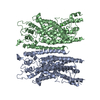
|
|---|---|
| 1 |
|
- Components
Components
| #1: Protein |  Calcium-dependent chloride channel / Transmembrane protein 16A Calcium-dependent chloride channel / Transmembrane protein 16AMass: 105603.984 Da / Num. of mol.: 2 Source method: isolated from a genetically manipulated source Details: Calcium ions / Source: (gene. exp.)   Mus musculus (house mouse) / Gene: Ano1, Tmem16a / Production host: Mus musculus (house mouse) / Gene: Ano1, Tmem16a / Production host:   Homo sapiens (human) / References: UniProt: Q8BHY3 Homo sapiens (human) / References: UniProt: Q8BHY3#2: Chemical | |
|---|
-Experimental details
-Experiment
| Experiment | Method:  ELECTRON MICROSCOPY ELECTRON MICROSCOPY |
|---|---|
| EM experiment | Aggregation state: PARTICLE / 3D reconstruction method:  single particle reconstruction single particle reconstruction |
- Sample preparation
Sample preparation
| Component | Name: TMEM16A Calcium-activated chloride channel / Type: CELL / Entity ID: #1 / Source: RECOMBINANT | |||||||||||||||||||||||||
|---|---|---|---|---|---|---|---|---|---|---|---|---|---|---|---|---|---|---|---|---|---|---|---|---|---|---|
| Source (natural) | Organism:   Mus musculus (house mouse) Mus musculus (house mouse) | |||||||||||||||||||||||||
| Source (recombinant) | Organism:   Homo sapiens (human) Homo sapiens (human) | |||||||||||||||||||||||||
| Buffer solution | pH: 9 | |||||||||||||||||||||||||
| Buffer component |
| |||||||||||||||||||||||||
| Specimen | Conc.: 0.5 mg/ml / Embedding applied: NO / Shadowing applied: NO / Staining applied : NO / Vitrification applied : NO / Vitrification applied : YES : YES | |||||||||||||||||||||||||
| Specimen support | Grid material: COPPER / Grid mesh size: 400 divisions/in. / Grid type: Quantifoil R1.2/1.3 | |||||||||||||||||||||||||
Vitrification | Instrument: FEI VITROBOT MARK III / Cryogen name: ETHANE / Humidity: 100 % / Chamber temperature: 277 K / Details: blot 6-8 seconds before plunging |
- Electron microscopy imaging
Electron microscopy imaging
| Experimental equipment |  Model: Titan Krios / Image courtesy: FEI Company |
|---|---|
| Microscopy | Model: FEI TITAN KRIOS |
| Electron gun | Electron source : :  FIELD EMISSION GUN / Accelerating voltage: 300 kV / Illumination mode: FLOOD BEAM FIELD EMISSION GUN / Accelerating voltage: 300 kV / Illumination mode: FLOOD BEAM |
| Electron lens | Mode: BRIGHT FIELD Bright-field microscopy / Calibrated magnification: 29000 X / Calibrated defocus min: 800 nm / Calibrated defocus max: 1900 nm / Cs Bright-field microscopy / Calibrated magnification: 29000 X / Calibrated defocus min: 800 nm / Calibrated defocus max: 1900 nm / Cs : 2.7 mm / C2 aperture diameter: 100 µm / Alignment procedure: COMA FREE : 2.7 mm / C2 aperture diameter: 100 µm / Alignment procedure: COMA FREE |
| Specimen holder | Cryogen: NITROGEN / Specimen holder model: FEI TITAN KRIOS AUTOGRID HOLDER |
| Image recording | Average exposure time: 8 sec. / Electron dose: 80 e/Å2 / Detector mode: SUPER-RESOLUTION / Film or detector model: GATAN K2 SUMMIT (4k x 4k) / Num. of grids imaged: 2 / Num. of real images: 7882 Details: 5326 images for TMEM16A alone in LMNG, 2556 images for TMEM16A with Fab bound in LMNG |
| Image scans | Movie frames/image: 40 / Used frames/image: 1-40 |
- Processing
Processing
| Software | Name: PHENIX / Version: 1.12_2829: / Classification: refinement | ||||||||||||||||||||||||||||||||
|---|---|---|---|---|---|---|---|---|---|---|---|---|---|---|---|---|---|---|---|---|---|---|---|---|---|---|---|---|---|---|---|---|---|
| EM software |
| ||||||||||||||||||||||||||||||||
CTF correction | Type: NONE | ||||||||||||||||||||||||||||||||
| Particle selection | Num. of particles selected: 927414 | ||||||||||||||||||||||||||||||||
| Symmetry | Point symmetry : C2 (2 fold cyclic : C2 (2 fold cyclic ) ) | ||||||||||||||||||||||||||||||||
3D reconstruction | Resolution: 3.8 Å / Resolution method: FSC 0.143 CUT-OFF / Num. of particles: 251851 / Algorithm: BACK PROJECTION / Num. of class averages: 2 / Symmetry type: POINT | ||||||||||||||||||||||||||||||||
| Atomic model building | Protocol: AB INITIO MODEL / Space: REAL | ||||||||||||||||||||||||||||||||
| Refine LS restraints |
|
 Movie
Movie Controller
Controller


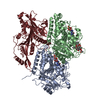
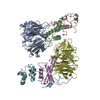
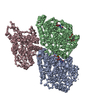
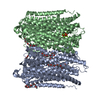
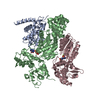

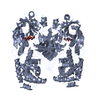
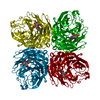
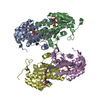
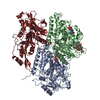
 PDBj
PDBj

